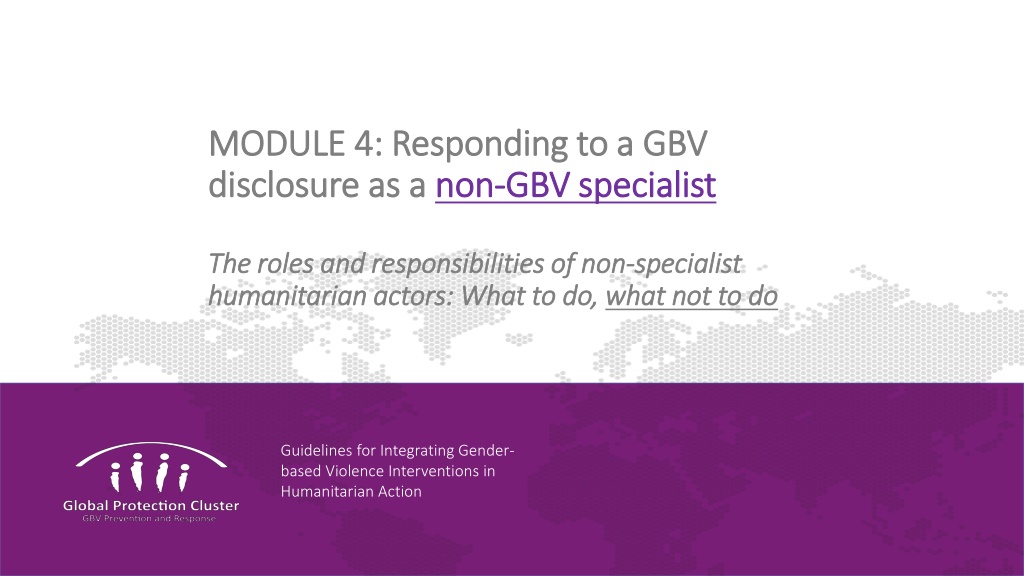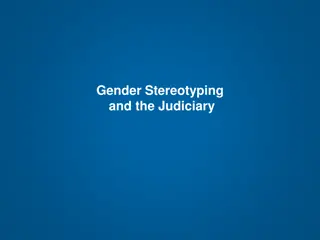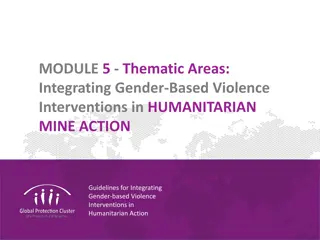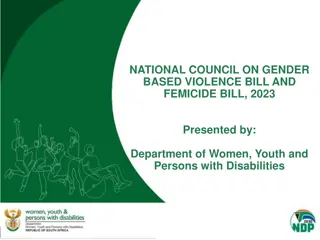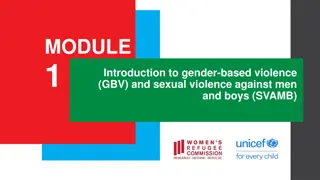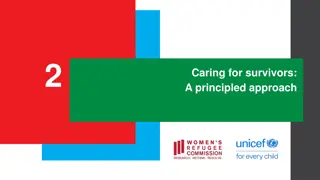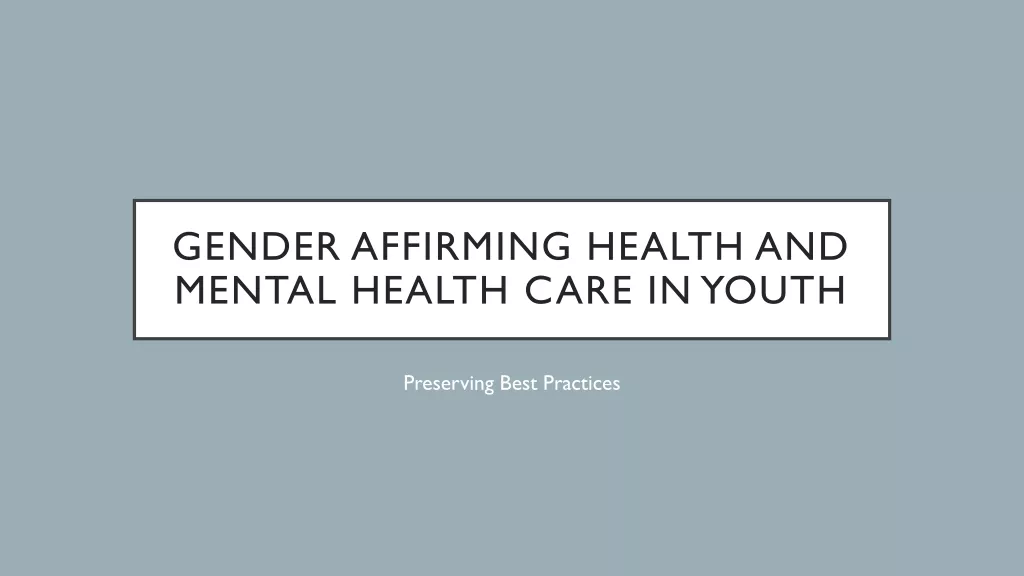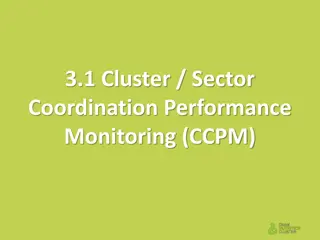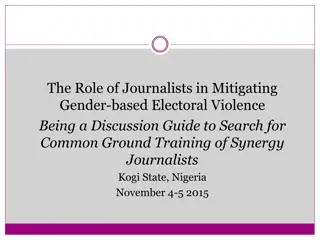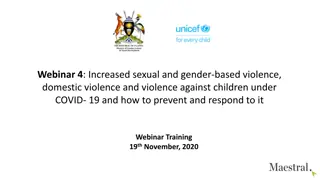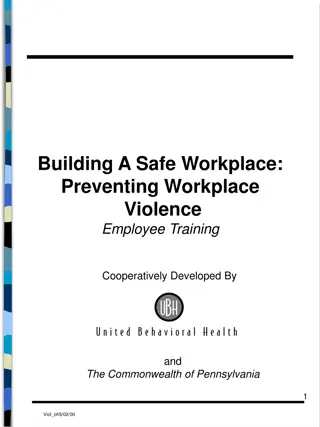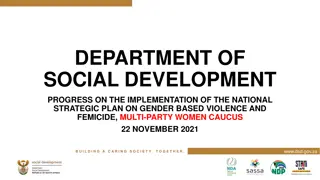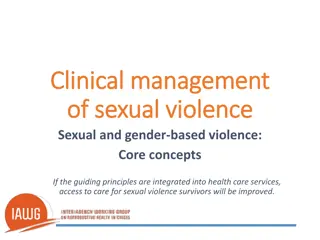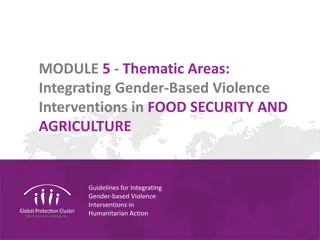Guidelines for Survivor-Centered Approach in Responding to Gender-Based Violence
Survivor-centered approach in responding to gender-based violence focuses on creating a supportive environment where survivors' rights are respected, promoting recovery, reinforcing decision-making capacity, and ensuring dignity and respect. It involves addressing victim-blaming attitudes, empowering survivors, providing privacy and confidentiality, and combating shame and stigma. Referrals play a crucial role in linking survivors to professional support services in a safe and ethical manner, encompassing health, psychosocial, security, legal, and economic reintegration support.
Download Presentation

Please find below an Image/Link to download the presentation.
The content on the website is provided AS IS for your information and personal use only. It may not be sold, licensed, or shared on other websites without obtaining consent from the author. Download presentation by click this link. If you encounter any issues during the download, it is possible that the publisher has removed the file from their server.
E N D
Presentation Transcript
MODULE 4: Responding to a GBV MODULE 4: Responding to a GBV disclosure as a disclosure as a non non- -GBV specialist GBV specialist The roles and responsibilities of The roles and responsibilities of non humanitarian actors: What to do, humanitarian actors: What to do, what not to do non- -specialist specialist what not to do Guidelines for Integrating Gender- based Violence Interventions in Humanitarian Action
Introducing the Survivor-centered Approach Guidelines for Integrating Gender- based Violence Interventions in Humanitarian Action
Survivor-centered approach A survivor-centred approach aims to create a supportive environment in which a survivor s rights are respected and in which s/he is treated with dignity and respect. The approach helps to promote a survivor s recovery and his/her ability to identify and express needs and wishes, as well as to reinforce his/her capacity to make decisions about possible interventions. Guidelines for Integrating Gender-based Violence Interventions in Humanitarian Action
Survivor-centered Approach To be treated with dignity and respect Victim-blaming attitudes To choose Feeling powerless To privacy and confidentiality Shame and stigma Vs. To non-discrimination Discrimination on the basis of gender, ethnicity, etc. To information Being told what to do To safety Being cast out Guidelines for Integrating Gender-based Violence Interventions in Humanitarian Action
Understanding Referrals Guidelines for Integrating Gender- based Violence Interventions in Humanitarian Action
What are referrals? The processes by which a survivor gets in touch with professionals and/or institutions regarding her case AND The processes by which different professional sectors communicate and work together, in a safe, ethical and confidential manner, to provide the survivor with comprehensive support Guidelines for Integrating Gender-based Violence Interventions in Humanitarian Action
What is a referral pathway? A flexible mechanism that safely links survivors to supportive and competent services Can include any or all of the following: Health, Psychosocial, Security and Protection, Legal/Justice, and/or Economic Reintegration support Guidelines for Integrating Gender-based Violence Interventions in Humanitarian Action
Why are referrals needed? Survivors typically have multiple and complex needs that require a comprehensive set of services One single organization cannot effectively provide all of these services Coordinated, multi-sectoral response is necessary Guidelines for Integrating Gender-based Violence Interventions in Humanitarian Action
Who should be involved in referrals? From the GBV AoR SOP template package: A survivor has the freedom and the right to disclose an incident to anyone. Anyone the survivor tells about her experience has a responsibility to give honest and complete information about services available, to encourage her to seek help, and to accompany her and support her through the process whenever possible. Providing information to survivors in a safe, ethical and confidential manner about their rights and options to report risk and access care is a responsibility of ALL humanitarian actors who interact with affected populations Guidelines for Integrating Gender-based Violence Interventions in Humanitarian Action
Activity: Referral Web Guidelines for Integrating Gender-based Violence Interventions in Humanitarian Action
Coordination, guiding principles, referral mechanisms health psychosocial Refugees/IDPs (individuals, Groups, etc.) Security & protection Legal/justice UN agencies, government authorities, NGOs, host/local socities
Referral pathway in practice Guidelines for Integrating Gender-based Violence Interventions in Humanitarian Action
Referral pathway on paper Guidelines for Integrating Gender-based Violence Interventions in Humanitarian Action
Suggested recommendations about referrals in the Guidelines All humanitarian personnel who engage with affected populations should have up to date written information about where to refer survivors for care and support. Ensure training on how to respectfully and supportively engage with survivors and provide risk reporting and/or referral information in an ethical, safe and confidential manner Any programmes that share information about reports of GBV must abide by safety and ethical standards (e.g. shared information does not reveal the identity of or pose a security risk to individual survivors, their families or the broader community) Guidelines for Integrating Gender-based Violence Interventions in Humanitarian Action
Defining Psychological First Aid (PFA) Guidelines for Integrating Gender- based Violence Interventions in Humanitarian Action
but Im not a GBV specialist what can I do to provide care? Psychological First Aid (PSA) describes human, supportive response to a fellow human being who is suffering and who may need support Guidelines for Integrating Gender-based Violence Interventions in Humanitarian Action
PFA Action Principles Understand the context in which you work (conflict, vulnerable groups, etc.) Understand the available services and supports Understand safety and security concerns Prepare Check for safety Check for people with urgent basic needs Check for people with serious distress reactions Look Approach people who may need support Listen to people and help them to feel calm Do not ask details about GBV Ask about people s needs and concerns Listen Help people address basic needs and access services Help people cope with problems Give information Connect people with loved ones and social support Link Guidelines for Integrating Gender-based Violence Interventions in Humanitarian Action
Providing PFA responsibly means: Respect, safety, dignity and rights Adapt what you do to take account of the person s culture Be aware of other emergency response measures Look after yourself Guidelines for Integrating Gender-based Violence Interventions in Humanitarian Action
LIVES ACRONYM Listen Listen to the woman closely, with empathy, and without judging. Inquire about needs and concerns Assess and respond to her various needs and concerns emotional, physical, social and practical (e.g. childcare) Validate Show her that you understand and believe her. Assure her that she is not to blame. Enhance safety Discuss a plan to protect herself from further harm if violence occurs again. Support Support her by helping her connect to information, services and social support. Guidelines for Integrating Gender-based Violence Interventions in Humanitarian Action
PFA: Activity In small groups: An incident of sexual violence has happened in a refugee camp. Many people from the community witnessed it, intervened and informed the camp manager. The survivor is known to the community but has not disclosed to you. What do you do? PFA Case Scenario Group 1: You are visiting a woman enrolled in one of your sectoral activities. Her family has been displaced and lives with a host family. She tells you that husband of the host family has sexually abused her 12 year old daughter and she doesn t know what to do but she doesn t want to report the incident. What do you do? PFA Case Scenario Group 2: Guidelines for Integrating Gender-based Violence Interventions in Humanitarian Action
Applying GBV Guiding Principles Guidelines for Integrating Gender- based Violence Interventions in Humanitarian Action
GBV Guiding Principles Preventing and mitigating GBV involves promoting gender equality and respectful, non-violent gender norms Safety, respect, confidentiality and non-discrimination in relation to survivors and those at risk must be ensured GBV related interventions should be context-specific Participation and partnership are essential for effective GBV prevention Guidelines for Integrating Gender-based Violence Interventions in Humanitarian Action
Case Study 1: Even before the IDPs started arriving to their new camp, the international media made it well known that sexual violence perpetrated by armed combatants was a common occurrence and they particularly targeted teenage girls. The start up of humanitarian aid was under a microscope the media and headquarters offices were watching closely to see that services for providers were put into place quickly. And the CCCM sector was ready before the big influxes arrived! CCCM actors recruited shelter and health programmers to build temporary health centers for survivors of rape in the plots next to where the schools would be built. This situation is a good example of adherence to the guiding principles/approaches. Agree? Disagree? Not sure? Guidelines for Integrating Gender-based Violence Interventions in Humanitarian Action
Case Study 2: Maya is an IDP camp manager working with a national NGO. A woman has reported to Maya four times about abuse she has suffered by her husband. Each time, Maya gives her information on where she can access assistance, but the woman opts to go to her home instead. Maya is very worried about the woman and seeks advice during a CCCM coordination meeting about what to do about her, providing coordination partners with details about where Maya and her husband live in the hopes that partners can monitor her safety. This situation is a good example of adherence to the guiding principles/approaches. Agree? Disagree? Not sure? Guidelines for Integrating Gender-based Violence Interventions in Humanitarian Action
Case Study 3: In a camp in Western Bina, where conflict has raged for nearly 13 years, rape is a daily reality for many IDP women and girls. The successful prosecution of rape cases is rare. In order to bring more perpetrators to trial, the Western Bina GBV Coordination Working Group inserted text in their SOPs that mandated that humanitarian actors receiving reports of GBV share information about the survivors with the chief of police. CCCM programmers helped to distribute this referral information to all those working in the camp. This situation is a good example of adherence to the guiding principles/approaches. Agree? Disagree? Not sure? Guidelines for Integrating Gender-based Violence Interventions in Humanitarian Action
Case Study 4: Media reports came out that two young girls had been raped near the water point outside of Twulah camp. At the coordination meeting it was decided that the four UN agencies most engaged in GBV work in and around the IDP camps should immediately jump in to support them. Each agency went to interview the girls and each spoke to them at length about what had happened. They then met together to develop a plan of action that would ensure both immediate assistance and long-term, holistic care for the girls in all relevant sectors of response: health, psychosocial, security and legal. This situation is a good example of adherence to the guiding principles/approaches. Agree? Disagree? Not sure? Guidelines for Integrating Gender-based Violence Interventions in Humanitarian Action
Case Study 5: Dapang community has been displaced for several years. The community values the family unit as a cornerstone of their culture which must be preserved. Any conflict within the home is traditionally referred to a Community Council. The GBV coordination body working in the area developed an SOP for GBV to be culturally sensitive and support community-based approaches. The SOP states that married women who experience violence in the home should be referred to the Community Council and not the police or formal justice system. All humanitarian actors, including health partners, were provided information about this referral strategy to implement this strategy. This situation is a good example of adherence to the guiding principles/approaches. Agree? Disagree? Not sure? Guidelines for Integrating Gender-based Violence Interventions in Humanitarian Action
Questions? Questions? Guidelines for Integrating Gender- based Violence Interventions in Humanitarian Action
